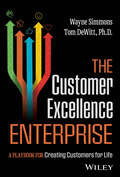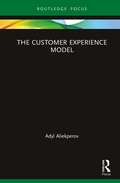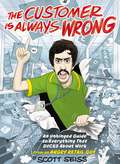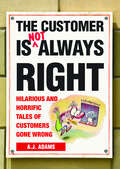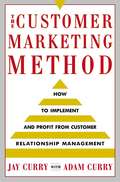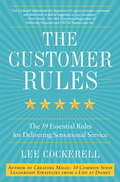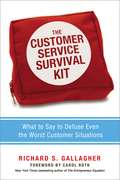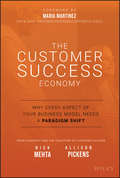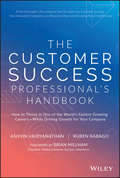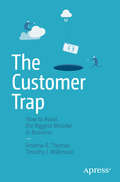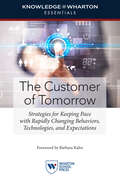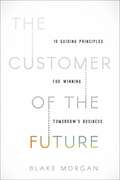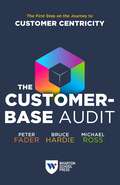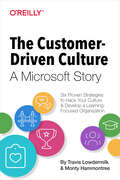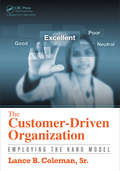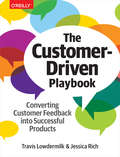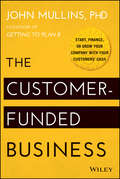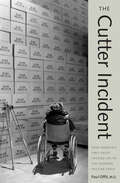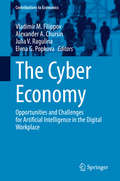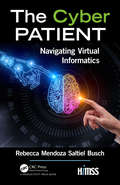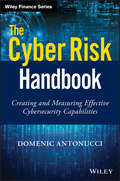- Table View
- List View
The Customer Excellence Enterprise: A Playbook for Creating Customers for Life
by Wayne Simmons Tom DeWittMake customer-centricity tangible, sustainable, and real by implementing structural and systemic changes to the DNA of your company. Businesses need to do more than sell to customers—they need to help them live their best lives. This superior experience is what customers expect and deserve from companies and it’s possible to deliver just that with the framework provided in The Customer Excellence Enterprise: A Playbook for Creating Customers for Life. An enlightening and pragmatic guide, The Customer Excellence Enterprise is for everyone who needs to elevate the customer experience to a fundamental revenue accelerator and value driver. With this fresh perspective on customer-centricity, companies can address the persistent disconnect between their customer-first claims and an often disappointing reality. Wayne Simmons and Tom DeWitt are practitioners and professors of customer excellence. Wayne is a leader in customer excellence and customer experience management at Pfizer, the Fortune 50 global leader in health care and life sciences. Tom is the founder of CXM@MSU, an industry-facing entity designed to advance customer experience management thought and practice, and the founder and architect of North America’s first master’s degree in Customer Experience Management (CXM) at the Broad College of Business, Michigan State University. Together, they expertly frame the complexities of consistently delivering a superior customer experience at enterprise and global scale and provide a compelling case for urgency for companies to take the journey to become a Customer Excellence Enterprise (CXE). Outlining the leadership, organizational, operational, and commercial facets essential for sustained success, The Customer Excellence Enterprise is a comprehensive playbook for any company seeking to differentiate deeply from competitors and win preferred positions in the hearts and minds of today’s discerning customers. With insights into how companies can become structurally and systemically predisposed to deliver exceptional experiences, the authors draw on real-world practice and examples from customer experience “outliers”―companies renowned for consistently improving their customers' lives. Readers will also find: Practical strategies for building a case for urgency and mobilizing all levels of the enterprise to deliver tangible results. Winning methods to build deep emotional connections that lead to lifelong customer relationships. Insights into the habits and ways of working from customer experience industry outliers. The Customer Excellence Enterprise: A Playbook for Creating Customers for Life is a must-have for the boards of directors, C-Suite executives, line of business leaders and managers, marketers, sales teams, product leaders, human resources, customer experience, operations and other customer-facing professionals tasked with answering pressing questions like, Why are exceptional customer experiences still so rare? and If customers are truly the most valuable of corporate assets, why are they consistently being treated so poorly? This book serves as an invaluable tool and urgent call to action for anyone committed to elevating how customers are viewed, treated, and valued—the keys to creating customers for life.
The Customer Experience Model (Routledge Focus on Business and Management)
by Adyl AliekperovFor any company, defining the most efficient marketing concept to create a competitive customer experience (CX) is vital for sustained development. The focus of this research is the creation of a comprehensible practical approach to the development of client experience: the Сustomer Experience Model (CXM). The practical application of the CX model will allow companies to create value for their customers and key stakeholders, thus generating the necessary profit and building conditions for further development. Balancing academic research and real-world applications, The Customer Experience Model provides a framework that readers can understand and utilize to implement improvements in a company. In this work the readers also will learn about application in customer experience formation of such concepts as "systems thinking", "learning organization", "Lewinian Experiential learning cycle". The role of a leader in the formation of an effective customer experience will be shown as well. Also the readers will get an obvious idea of how to plan customer experience and measure its effectiveness. The Customer Experience Model shows the latest state of knowledge on the topic and will be of interest both to students of business schools and universities at an advanced level, academics and reflective practitioners in the fields of leadership, organizational studies, marketing, and strategic management and consulting.
The Customer Is Always Wrong: An Unhinged Guide to Everything That Sucks About Work (from an Angry Retail Guy)
by Scott SeissCustomers want you to magically produce something from the back room. Bosses schedule you on your day off. Corporate policies are mandated that make zero practical sense. Sound familiar?If you've ever worked in customer service (or any job, really), you know that everyone else—the customer, the boss, the company—is always right, and never the employee. Well, lucky for you, the "Angry Retail Guy" is more furious—and funnier—than ever in this hilariously unhinged guide to all the things we wish we could say out loud at work . . . without getting fired. In The Customer Is Always Wrong, you'll laugh (and maybe cry) at this rant-filled, illustrated attack on all the frustrating things that suck about work.Expanding on the ire-filled, laugh-out-loud viral videos that have made him a (whispered) workplace name, Scott Seiss joyfully eviscerates not only overbearing customers but every annoying aspect of work like purposeless job interview questions, debatable brand values, and the walking human trainwrecks that are our bosses. Scott guides you all the way from first applying to the job, to inevitably gritting your teeth and smiling on your last day when that one manager you despise says, &“Come back and visit us!&”The Customer Is Always Wrong is for anyone who:Is tired of their "raise" being as close as scientifically possible to 0 percentWants to tell their boss that not even the self-checkout machines want to work hereIs prepared to tell the next customer who asks to see the manager that the manager has no idea what's going on eitherCalls in sick whenever their PTO request is deniedBelieves entering a store five minutes before it closes should be illegalExplains, on a weekly basis, why someone can't use a coupon that expired 17 years agoIs physically repulsed by the phrase, "At this company, we're a family. . . ." This tongue-in-cheek commiseration for workers will make you laugh out loud at the things that drive you crazy in the workplace. With Scott's signature rants, funny anecdotes, and absurd musings, this book celebrates and empowers underpaid and overworked employees with an uproarious, illustrated ode to what we really think about our jobs and the customers that come with them (except the ones who read this book, of course).
The Customer Is Not Always Right: Hilarious and Horrific Tales of Customers Gone Wrong
by A.J. AdamsService workers share their funniest and most cringeworthy stories of difficult, demanding, and just plain mind-boggling encounters with the public . . . “Ma’am, the rules clearly state that you cannot have any liquids over 3.4 ounces in your carry-on. If you’d like to, you could—”“But that’s not a liquid!”“Excuse me, ma’am?”“It’s not a liquid! It’s water!”Retailers, restaurants, and tech support providers believe service is king, but in The Customer Is Not Always Right, A.J. Adams proves that customers will do anything they can to put that motto to the test.Enjoy tales from the creator of the popular website Not Always Right, including half that are previously unpublished, showcasing customer-relations horror stories everyone can relate to. No matter what side of the counter you’re on, there are hilarious accounts about everything that can go wrong between the customer and retail or service provider. Whether it's a confrontation in the drive-through over not enough fries or arguing over a one-cent price difference on milk, this book proves the principle of “the customer is always right” can be dead wrong.
The Customer Marketing Method
by Jay Curry Adam CurryToday the hottest new area of marketing is Customer Relationship Management (CRM) -- the discipline of identifying, attracting, and retaining a company¹s most valuable customers. Drawing upon more than ten years of testing, tryout, and implementation in hundreds of companies, CRM expert Jay Curry, and his Internet-expert son, Adam Curry, have written a clear, step-by-step guide to profiting from this exploding movement, with strategies that are aimed at the small and medium-sized business owners who need them most. Jay Curry explains how CRM can help managers boost profits by implementing a customer-focused strategy. Using easy-to-understand graphics, he introduces the customer pyramid -- segmented as "Top," "Big," "Medium," and "Small" -- to help the reader visualize, analyze, and improve customer profitability. Success comes to those who follow this three-step Customer Marketing Strategy: (1) get new customers into your pyramid; (2) move customers higher into your pyramid; (3) keep the customers in the pyramid. Combining practical how-to directives with vital CRM reference information, the book includes a case study, "InterTech," that allows readers to see customer-focused strategy in action. The final third of this practical, easy-to-read book is devoted to the Internet. Here Adam Curry introduces the "Permission Pyramid" and the "e-Customer Marketing Pyramid" to explain the nature of "virtual customer relationships" and how to use them to create, keep, and upgrade customers. This section includes mini-cases and tips to help managers use the Internet to complement current marketing and sales activities and ends with guidelines to test out the new paradigms of e-commerce. Throughout The Customer Marketing Method, the emphasis is always on practical steps to "make it happen." It is essential and timely reading for owners of small and medium-sized businesses as well as managers of small business units within larger firms.
The Customer Rules: The 39 Essential Rules for Delivering Sensational Service
by Lee CockerellThe former EVP of Walt Disney World shares indispensible Rules for serving customers with consistency, efficiency, creativity, sincerity, and excellence. Lee Cockerell knows that success in business - any business - depends upon winning and keeping customers.In 39 digestible, bite-sized chapters, Lee shares everything he has learned in his 40+ year career in the hospitality industry about creating an environment that keeps customers coming back for more. Here, Lee not only shows why the customer always rules, but also the Rules for serving customers so well they'll never want to do business with anyone but you. For example:Rule #1: Customer Service Is Not a DepartmentRule #3: Great Service Follows the Laws of Gravity Rule #5: Ask Yourself "What Would Mom Do?"Rule #19: Be a Copycat Rule #25. Treat Every Customer like a RegularRule #39: Don't Try Too HardAs simple as they are profound, these principles have been shown to work in companies as large as Disney and as small as a local coffee shop; from businesses selling cutting-edge technologies like computer tablets to those selling products as timeless as shoes and handbags; at corporations as long-standing as Ford Motors and those as nascent as a brand new start-up. And they have been proven indispensible at all levels of a company, from managers responsible for hiring and training employees, setting policies and procedures, and shaping the company culture to front line staff who deal directly with clients and customersChock-full of universal advice, applicable online and off, The Customer Rules is the essential handbook for service excellence everywhere.From the Hardcover edition.
The Customer Service Survival Kit: What to Say to Defuse Even the Worst Customer Situations
by Richard S. GallagherThe worst customer situations demand more of front-line employees than good intentions and the right attitude. These kinds of issues can send seasoned service professionals into red alert, and require the communication skills of a crisis counselor. The Customer Service Survival Kit explains how to use the right words toturn volatile scenarios into calm and productive customer encounters. Anyone can learn this delicate art with the book's blend of clear techniques, lessons from behavioral science, case studies, situation-specific advice, and practice exercises. Readers will discover: * The power of leaning into criticism * Trigger phrases that can make bad situations worse * The secret to helping people feel deeply heard in a crisis * How to use the divide-and-conquer approach to safely deliver bad news * Indispensable problem-solving tools * How to become immune to intimidation * How to wrap up transactions so that customers are happy * And more! Best yet, learning to handle worst-case scenarios has the spillover effect of boosting the skills and confidence needed to deal effectively with ANY customer - the key to radical improvements in every organization.
The Customer Success Economy: Why Every Aspect of Your Business Model Needs A Paradigm Shift
by Nick Mehta Allison PickensIf leaders aren't integrating their digital offerings into a philosophy of Customer Success, they will be defeated in the next decade, because technical excellence and other traditional competitive advantages are becoming too easy to imitate. The Customer Success Economy offers examples and specifics of how companies can transform. It addresses the pains of transforming organizational charts, leadership roles, responsibilities, and strategies so the whole company works together in total service to the customer. Shows leaders how their digital implementations will make them more Amazon-like Helps you deliver recurring revenue Shows you how to embrace customer retention Demonstrates the importance of "churning" less Get that competitive advantage in the most relevant and important arena today—making and cultivating happy customers.
The Customer Success Professional's Handbook: How to Thrive in One of the World's Fastest Growing Careers—While Driving Growth For Your Company
by Ashvin Vaidyanathan Ruben RabagoThe definitive “Customer Success Manager How-To-Guide” for the CSM profession from Gainsight, who brought you the market-leading Customer Success The Customer Success Manager has become a critical asset to organizations across the business landscape. As the subscription model has spread from the cloud and SaaS to more sectors of the economy, that pivotal role will only grow in importance. That’s because if you want to compete and thrive in this new environment, you need to put the customer at the center of your strategy. You need to recognize you’re no longer selling just a product. You’re selling an outcome. Customer Success Managers (CSM) are committed to capturing and delivering those outcomes by listening to their customers, understanding their needs, and adapting products and services to drive success. Although several existing resources address the customer success imperative, there is no authoritative instruction manual for the CSM profession—until now. The Customer Success Professional’s Handbook is the definitive reference book for CSMs and similar roles in the field. This practical, first-of-its-kind manual fills a significant gap in professional customer success literature, providing the knowledge every CSM needs to succeed—from the practitioner level all the way to senior leadership. The authors—acknowledged experts in building, training, and managing Customer Success teams—offer real-world guidance and practical advice for aspiring and experienced CSMs alike. The handbook is written by practioners for practioners. An indispensable resource for front-line Customer Success Managers, this much-needed book: Demonstrates how to build, implement, and manage a Customer Success team Helps new CSMs develop their skills and proficiency to be more employable and grow in their careers Provides clear guidance for managers on how to hire a stellar CSM Presents practical tactics needed to drive revenue growth during renewal, expansion, and customer advocacy opportunities Explains proven methods and strategies for mentoring CSMs throughout their careers Offers valuable insights from Gainsight, the Customer Success Company, and the broader customer success community with more than a dozen of the industry’s most respected leaders contributing their perspectives Currently, with over 70,000 open positions, Customer Success Manager in one of the fastest-growing jobs in the world. The Customer Success Professional’s Handbook: How to Thrive in One of the World's Fastest Growing Careers—While Driving Growth For Your Company will prove to be your go-to manual throughout every stage of your CSM career.
The Customer Trap
by Andrew R. Thomas Timothy J. WilkinsonAmerican business is dysfunctional. Companies of all sizes follow the mistaken belief that their products and services are best sold through mega-customers with pervasive market reach, such as Amazon and Walmart. Far too many business leaders fail to realize--until it is too late--that the relentless pursuit of volume at all cost is not the key to long-term profits and success. The Customer Trap: How to Avoid the Biggest Mistake in Business is Thomas and Wilkinson''s sequel to The Distribution Trap: Keeping Your Innovations from Becoming Commodities, which won the Berry-American Marketing Association Prize for the best marketing book of 2010. The Distribution Trap contended that cracking the big-box channel is not necessarily the Holy Grail that many marketers assume it is. The Customer Trap takes this thesis to the next level by arguing that all companies, regardless of the industry there are in, should maintain control over their sales and distribution channels. Volume forgone by avoiding the mass market is more than offset by higher margins and stronger brand equity. The Customer Trap shows that giving power to a customer who violates "the ten percent rule" sets a company up for ruin. Yet, when presented with the opportunity to push more sales through large customers, most decision-makers jump at the chance. As a result, marketing has come to resemble a relentless quest for efficiency and scale. Demands from mega-customers in the form of discounts, deals, and incentives erode the integrity of the brand and what it originally stood for. Lower margins become the norm and cost-saving compromises on quality take over. In time, the brand suffers and, in some cases, fails outright. Stark examples from Oreck Vacuum Cleaners, Rubbermaid, Goodyear, Levi''s, and others illustrate the perils of falling into the "customer trap. " This book demonstrates in vivid detail how to thrive by controlling your sales and distribution. The authors show how many firms, such as STIHL Inc. , etailz, Apple, Red Ant Pants, and Columbia Paints & Coatings, have prospered by avoiding the "customer trap"--and how your company can have similar success. What you''ll learn Why making a deal with a mega-retailer is often a bad idea How innovators allow mega-customers to dilute the value of their products and services, while letting them impose costs and force changes in strategic direction and operational control How to take back control of your sales and distribution, using the newest direct marketing techniques and the most innovative electronic platforms How innovators can avoid the distribution trap, build a sustainable business, and maintain the brand equity and margins of the products and services they worked so hard to create Who this book is for Leaders of businesses of all sizes. Table of Contents Chapter 1. The Biggest Business Mistake Chapter 2. The Customer Trap and Brand Destruction Chapter 3. Turning Your Innovations into Commodities Chapter 4. When Sales Channels Get Hijacked Chapter 5. Living the Outsourcing CompulsionChapter 6. The STIHL Story Chapter 7. Innovation''s Second Step Chapter 8. Getting the Data and Doing Marketing Right Chapter 9. Going Global and Keeping the Faith Chapter 10. Staying Local and Independent
The Customer of Tomorrow: Strategies for Keeping Pace with Rapidly Changing Behaviors, Technologies, and Expectations (Knowledge@Wharton Essentials)
by Barbara E. Kahn Knowledge WhartonWith consumer decisions being made at increasing speed, and the time it takes to win wallet-share rapidly shrinking, how can you prepare?Today's customer has more access to information and influencers, at a click or swipe, than ever before. The speed at which consumer decisions are made keeps increasing, and the time it takes for battles over wallet-share to be won or lost is shrinking rapidly. Every fundamental assumption about customers is now being challenged: how they shop, where they shop, and why they shop. In this rapidly evolving environment, understanding consumers' behaviors is more critical than ever.The Customer of Tomorrow examines many of the changing behaviors, technologies, and expectations that companies must understand in order to build valuable and lasting relationships in the years to come. Drawn from the best of Knowledge@Wharton's reporting, this volume in the Knowledge@Wharton Essentials series features stories addressing:Customer loyalty in the age of big dataWhen more data doesn't mean better customer serviceHow to build loyal customers in the information ageWhy customer service is often the ignored side of social mediaWhen does it make sense to have a bricks & mortar location for customersHow to bring in new customersThis quick read features Knowledge@Wharton's reporting on the research and thought leadership of David Bell, Peter Fader, Barbara Kahn, among others. The Customer of Tomorrow will help you continue to win wallet-share with customers.About Knowledge@Wharton BooksInsights and inspiration business leaders can use today-from The Wharton School's online journal of business analysisKnowledge@Wharton Books offer you the signature reporting that Knowledge@Wharton readers have come to expect, including in-depth coverage and analysis of important business trends, accessible explanations of the latest business research, and inspiring conversations with today's thought leaders.Published exclusively as ebooks by Wharton Digital Press, this practical line of books includes two series:Knowledge@Wharton Originals: All-new, in-depth coverage of a timely important and business matter or trend, featuring key takeaways that business leaders and professionals can leverage immediatelyKnowledge@Wharton Essentials: Collects the best of Knowledge@Wharton's reporting on a single topic of significant business concern, laying out the challenges and offering solutionsEach Knowledge@Wharton ebook offers you what you need to address a business challenge or opportunity head on-today.
The Customer of the Future: 10 Guiding Principles for Winning Tomorrow's Business
by Blake MorganTomorrow’s customers need to be targeted today!With emerging technology transforming customer expectations, it’s more important than ever to keep a laser focus on the experience companies provide their customers.In The Customer of the Future, customer experience futurist Blake Morgan outlines ten easy-to-follow customer experience guidelines that integrate emerging technologies with effective strategies to combat disconnected processes, silo mentalities, and a lack of buyer perspective.Tomorrow’s customers will insist on experiences that make their lives significantly easier and better. Companies will win their business not by just proclaiming that customer experience is a priority but by embedding a customer focus into every aspect of their operations. They’ll understand how emerging technologies like artificial intelligence (AI), automation, and analytics are changing the game and craft a strategy to integrate them into their products and processes.The Customer of the Future explains how today’s customers are already demanding frictionless, personalized, on-demand experiences from their products and services, and companies that don’t adapt to these new expectations won’t last. This book prepares your organization for these increasing demands by helping you do the following:Learn the ten defining strategies for a customer experience–focused company.Implement new techniques to shift the entire company from being product-focused to being customer-focused.Gain insights through case studies and examples on how the world’s most innovative companies are offering new and compelling customer experiences.Craft a leadership development and culture plan to create lasting change at your organization.
The Customer-Base Audit: The First Step on the Journey to Customer Centricity
by Peter Fader Michael Ross Bruce G.S. HardieAs a leader in your organization, you will be very familiar with your organization’s key financial statements and monthly management reports. You may have spent countless hours discussing budgets and expenditures.But how much time have you spent reflecting on the fact that these revenues are generated by actual customers—the people who pull out their wallets and pay for your products and services? In The Customer-Base Audit: The First Step on the Journey to Customer Centricity, experts Peter Fader, Bruce Hardie, and Michael Ross start you on the path toward really getting to understand your customers’ buying behavior as well as the health of your overall customer base.A customer-base audit is a systematic review of the buying behavior of a firm’s customers using data captured by its transaction systems. It will help you answer questions such as:-- How healthy is your customer base? How realistic are your growth objectives?-- How do your customers differ in terms of their behavior and value?-- How has the quality of your customers changed over time?-- What changes in customer behavior lie behind period-to-period changes in firm performance?-- What is important to your high-value customers? Which products help you acquire and retain your best customers?Fader, Hardie, and Ross present five “lenses” through which an executive can address questions like those above. The answers are often lurking in various parts of the organization, but it is rare to find all the relevant analyses in one place, let alone performed on a regular basis (as an audit should be). Yet without such a basic, systematic understanding of the foundations of the firm’s primary source of cash flow, how can executives make informed decisions?Fader, a Wharton professor, is the author of Customer Centricity and coauthor of The Customer Centricity Playbook, both of which have helped businesses radically rethink how they relate to customers. In this first step of the journey, Fader, Hardie, and Ross assist leaders in gaining a fundamental understanding of their customers’ buying behavior—and thus their company as a whole.
The Customer-Driven Culture: Six Proven Strategies to Hack Your Culture and Develop a Learning-Focused Organization
by Travis Lowdermilk Monty HammontreeIf you’re striving to make products and services that your customers will love, then you’ll need a customer-driven organization. As companies transform their businesses to meet the demands of the digital age, they find themselves grappling with uniquely human challenges. Organizational knowledge becomes siloed, employees move to safeguard their expertise, and customer data creates polarization and infighting between teams. All of these challenges widen the distance between the people who make your products and the customers who use them.To meet today’s challenges, companies need to do more than build processes for customer-driven products. They need to create a customer-driven culture.With the help of his friend and mentor Monty Hammontree, Travis Lowdermilk takes readers through the cultural transformation of the Developer Division at Microsoft. This book shows readers how to "hack" their culture and reduce the distance between them and their customers’ needs. It’s a uniquely personal story that’s told amidst a cultural revolution at one of the largest software companies in the world.This story acts as your guide. You’ll learn how to:Establish a Common Language: Help employees change their thinking and actionsBuild Bridges, Not Walls: Treat product building as a team sportEncourage Learning Versus Knowing: Help your team understand their customersBuild Leaders That Build Your Culture: Showcase star employees to inspire othersMeet Teams Where They Are: Make it easy for teams to to adopt vital behavior changesMake Data Relatable: Move beyond numbers and focus on empathizing with customers
The Customer-Driven Organization: Employing the Kano Model
by Lance B. Coleman Sr.Does your organization provide customer satisfaction or does it inspire customer loyalty? Which is more important? See how lessons learned from the service sector were applied to manufacturing and other diverse settings, including the nonprofit sector and even on one‘s own home front.Exploring the Kano Model, The Customer-Driven Organization: Emplo
The Customer-Driven Playbook: Converting Customer Feedback into Successful Products
by Travis Lowdermilk Jessica RichDespite the wide acceptance of Lean approaches and customer-development strategies, many product teams still have difficulty putting these principles into meaningful action. That’s where The Customer-Driven Playbook comes in. This practical guide provides a complete end-to-end process that will help you understand customers, identify their problems, conceptualize new ideas, and create fantastic products they’ll love.To build successful products, you need to continually test your assumptions about your customers and the products you build. This book shows team leads, researchers, designers, and managers how to use the Hypothesis Progression Framework (HPF) to formulate, experiment with, and make sense of critical customer and product assumptions at every stage. With helpful tips, real-world examples, and complete guides, you’ll quickly learn how to turn Lean theory into action.Collect and formulate your assumptions into hypotheses that can be tested to unlock meaningful insightsConduct experiments to create a continual cadence of learningDerive patterns and meaning from the feedback you’ve collected from customersImprove your confidence when making strategic business and product decisionsTrack the progression of your assumptions, hypotheses, early ideas, concepts, and product features with step-by-step playbooksImprove customer satisfaction by creating a consistent feedback loop
The Customer-Funded Business: Start, Finance, or Grow Your Company with Your Customers' Cash
by John MullinsWho needs investors? More than two generations ago, the venture capital community – VCs, business angels, incubators and others – convinced the entrepreneurial world that writing business plans and raising venture capital constituted the twin centerpieces of entrepreneurial endeavor. They did so for good reasons: the sometimes astonishing returns they've delivered to their investors and the astonishingly large companies that their ecosystem has created. But the vast majority of fast-growing companies never take any venture capital. So where does the money come from to start and grow their companies? From a much more agreeable and hospitable source, their customers. That's exactly what Michael Dell, Bill Gates and Banana Republic's Mel and Patricia Ziegler did to get their companies up and running and turn them into iconic brands. In The Customer Funded Business, best-selling author John Mullins uncovers five novel approaches that scrappy and innovative 21st century entrepreneurs working in companies large and small have ingeniously adapted from their predecessors like Dell, Gates, and the Zieglers: Matchmaker models (Airbnb) Pay-in-advance models (Threadless) Subscription models (TutorVista) Scarcity models (Vente Privee) Service-to-product models (GoViral) Through the captivating stories of these and other inspiring companies from around the world, Mullins brings to life the five models and identifies the questions that angel or other investors will – and should! – ask of entrepreneurs or corporate innovators seeking to apply them. Drawing on in-depth interviews with entrepreneurs and investors who have actually put these models to use, Mullins goes on to address the key implementation issues that characterize each of the models: when to apply them, how best to apply them, and the pitfalls to watch out for. Whether you're an aspiring entrepreneur lacking the start-up capital you need, an early-stage entrepreneur trying to get your cash-starved venture into take-off mode, an intrapreneur seeking funding within an established company, or an angel investor or mentor who supports high-potential ventures, this book offers the most sure-footed path to starting, financing, or growing your venture. John Mullins is the author of The New Business Road Test and, with Randy Komisar, the widely acclaimed Getting to Plan B.
The Customering Method: From CX Dogma to Customer Science
by Aarron SpinleyDespite the promise of enhanced customer engagement through new technology, consumer trust has suffered widespread collapse and annual corporate losses are in the trillions. This book exposes the faulty foundation of the populist Customer Experience (CX) movement, upturns long-held beliefs in its effectiveness, and details an alternative – industrial – approach to the customer asset base.Aarron Spinley is recognized as a foremost mind in the realm of customer science and strategy. His work helps us to understand – and extract – customer value based on evidence, and in so doing, influences our relationship with technology for better results. The Customering Method marries the sciences and managerial precedent with contemporary capability: optimizing the intersection with marketing, mitigating risk and attrition rates, increasing sales propensity, and restoring profitability. Throughout, Spinley provides practical examples that are relatable, actionable, and defensible.These concepts have already influenced senior leaders, CEOs, chief marketing officers, and directors of customer experience across many organizations. Now in published form, this is perhaps the most important book in the field for decades.
The Cutter Incident: How America's First Polio Vaccine Led to the Growing Vaccine Crisis
by Paul A. OffitA history and analysis of the tragic 1955 American pharmaceutical disaster involving one company’s polio vaccine.Vaccines have saved more lives than any other single medical advance. Yet today only four companies make vaccines, and there is a growing crisis in vaccine availability. Why has this happened? This remarkable book recounts for the first time a devastating episode in 1955 at Cutter Laboratories in Berkeley, California, that has led many pharmaceutical companies to abandon vaccine manufacture.Drawing on interviews with public health officials, pharmaceutical company executives, attorneys, Cutter employees, and victims of the vaccine, as well as on previously unavailable archives, Dr. Paul Offit offers a full account of the Cutter disaster. He describes the nation’s relief when the polio vaccine was developed by Jonas Salk in 1955, the production of the vaccine at industrial facilities such as the one operated by Cutter, and the tragedy that occurred when 200,000 people were inadvertently injected with live virulent polio virus: 70,000 became ill, 200 were permanently paralyzed, and 10 died. Dr. Offit also explores how, because of the tragedy, one jury’s verdict set in motion events that eventually suppressed the production of vaccines already licensed and deterred the development of new vaccines that hold the promise of preventing other fatal diseases.Praise for The Cutter Incident“Offit . . . has written a fascinating and highly readable account of the development of the polio vaccine. He also offers a compelling plea for a strengthened law to provide relief to companies that produce vaccines so that our nation may be afforded the most cost-effective and long-lasting form of prevention against many infectious diseases—an effective vaccine.” —Stanley Goldfarb, New York Post“The best account you will ever read about the interplay between big drug companies and bigger government.” —Peter Huber, Forbes“The book is very well written and reads almost like a detective story, with a nice balance between personal anecdotes and new materials not discussed in other accounts of the Cutter incident. It draws on meticulous archival documentation and on interviews with public health officers, pharmaceutical company executives, Cutter employees, and victims of the partially inactivated vaccine. . . . An important and valuable contribution.” —Nadav Davidovitch, Isis“Well written and easily understood, yet balanced with enough technical detail for medical professionals to read informatively cover to cover.” —Journal of the American Medical Association
The Cyber Economy: Opportunities and Challenges for Artificial Intelligence in the Digital Workplace (Contributions to Economics)
by Elena G. Popkova Vladimir M. Filippov Alexander A. Chursin Julia V. RagulinaThe transition to Industry 4.0, and the subsequent ubiquitous digitalization and integration of artificial intelligence (AI) into the economic system, has set the stage for a fundamental change - one towards forming a cyber economy: a type of economy in which humans are economic subjects who interact with or are confronted with AI. This book examines these interactions and specifically analyzes the overall effects of digitalization on the workplace, and on the economic system of the future. Scholars from a diverse range of fields address both the challenges and opportunities of using AI in business sectors, as well as the role of people dealing with digital channels. In closing, the book discusses the need to, and options for, training and educating the labor force in the digital age.
The Cyber Patient: Navigating Virtual Informatics (HIMSS Book Series)
by Rebecca Mendoza Saltiel BuschWith the use of electronic health records (EHR) transforming the healthcare industry, the use of information technology in the maintenance of personal health records poses a range of issues and opportunities for every medical organization, The Cyber Patient expertly walks readers through the elements required for an efficient, well-run healthcare record management system, while reflecting the U.S. government’s goal of achieving widespread adoption of interoperable electronic health records to improve the quality and efficiency of healthcare while maintaining the levels of security and privacy that consumers expect. The author also provides an update as to where the industry stands in their push of interoperability and the increased use of data as an analytic tools. Providing an application readers can adopt as a model, this important book examines the infrastructure of electronic health records and how government criteria have impacted and will continue to impact both private and public marketplaces. This valuable resource also addresses how auditors, controllers, and healthcare providers can keep up with the market’s continued move towards an interoperable e-health world, without neglecting clinical and financial accountability in the delivery of healthcare. As e-health continues to develop and transform, The Cyber Patient thoughtfully prepares professionals to plan and implement an effective EHR as wel as internal controls system within any clinical setting.
The Cyber Risk Handbook: Creating and Measuring Effective Cybersecurity Capabilities (Wiley Finance)
by Domenic AntonucciActionable guidance and expert perspective for real-world cybersecurity The Cyber Risk Handbook is the practitioner's guide to implementing, measuring and improving the counter-cyber capabilities of the modern enterprise. The first resource of its kind, this book provides authoritative guidance for real-world situations, and cross-functional solutions for enterprise-wide improvement. Beginning with an overview of counter-cyber evolution, the discussion quickly turns practical with design and implementation guidance for the range of capabilities expected of a robust cyber risk management system that is integrated with the enterprise risk management (ERM) system. Expert contributors from around the globe weigh in on specialized topics with tools and techniques to help any type or size of organization create a robust system tailored to its needs. Chapter summaries of required capabilities are aggregated to provide a new cyber risk maturity model used to benchmark capabilities and to road-map gap-improvement. Cyber risk is a fast-growing enterprise risk, not just an IT risk. Yet seldom is guidance provided as to what this means. This book is the first to tackle in detail those enterprise-wide capabilities expected by Board, CEO and Internal Audit, of the diverse executive management functions that need to team up with the Information Security function in order to provide integrated solutions. Learn how cyber risk management can be integrated to better protect your enterprise Design and benchmark new and improved practical counter-cyber capabilities Examine planning and implementation approaches, models, methods, and more Adopt a new cyber risk maturity model tailored to your enterprise needs The need to manage cyber risk across the enterprise—inclusive of the IT operations—is a growing concern as massive data breaches make the news on an alarmingly frequent basis. With a cyber risk management system now a business-necessary requirement, practitioners need to assess the effectiveness of their current system, and measure its gap-improvement over time in response to a dynamic and fast-moving threat landscape. The Cyber Risk Handbook brings the world's best thinking to bear on aligning that system to the enterprise and vice-a-versa. Every functional head of any organization must have a copy at-hand to understand their role in achieving that alignment.
The Cybersecurity Playbook: How Every Leader and Employee Can Contribute to a Culture of Security
by Allison CerraThe real-world guide to defeating hackers and keeping your business secure Many books discuss the technical underpinnings and complex configurations necessary for cybersecurity—but they fail to address the everyday steps that boards, managers, and employees can take to prevent attacks. The Cybersecurity Playbook is the step-by-step guide to protecting your organization from unknown threats and integrating good security habits into everyday business situations. This book provides clear guidance on how to identify weaknesses, assess possible threats, and implement effective policies. Recognizing that an organization’s security is only as strong as its weakest link, this book offers specific strategies for employees at every level. Drawing from her experience as CMO of one of the world’s largest cybersecurity companies, author Allison Cerra incorporates straightforward assessments, adaptable action plans, and many current examples to provide practical recommendations for cybersecurity policies. By demystifying cybersecurity and applying the central concepts to real-world business scenarios, this book will help you: Deploy cybersecurity measures using easy-to-follow methods and proven techniques Develop a practical security plan tailor-made for your specific needs Incorporate vital security practices into your everyday workflow quickly and efficiently The ever-increasing connectivity of modern organizations, and their heavy use of cloud-based solutions present unique challenges: data breaches, malicious software infections, and cyberattacks have become commonplace and costly to organizations worldwide. The Cybersecurity Playbook is the invaluable guide to identifying security gaps, getting buy-in from the top, promoting effective daily security routines, and safeguarding vital resources. Strong cybersecurity is no longer the sole responsibility of IT departments, but that of every executive, manager, and employee.
The Cyberunion Handbook: Transforming Labor Through Computer Technology
by Arthur B ShostakIn his original CyberUnion, the author presented a bold plan for unions to develop a more significant role in the 21st century by adopting four strategic aids - futuristics, innovations, services, and traditions (F-I-S-T) - knit together by cutting-edge Info Tech resources. CyberUnions in Action expands on the F-I-S-T model and looks at gains and setbacks in pioneering efforts to create "CyberUnions". It highlights relevant websites, and features interviews with key CyberUnion advocates (and some critics). Shostak reviews overseas union efforts for transferable lessons, and pays special attention to the AFL-CIO campaign to ensure Labor's advances in the use of computer networks, the Internet, wireless devices, and more.
The Cycle of Coalition: How Parties and Voters Interact under Coalition Governance
by David FortunatoHow does coalition governance shape voters' perceptions of government parties and how does this, in turn, influence party behaviors? Analyzing cross-national panel surveys, election results, experiments, legislative amendments, media reports, and parliamentary speeches, Fortunato finds that coalition compromise can damage parties' reputations for competence as well as their policy brands in the eyes of voters. This incentivizes cabinet partners to take stands against one another throughout the legislative process in order to protect themselves from potential electoral losses. The Cycle of Coalition has broad implications for our understanding of electoral outcomes, partisan choices in campaigns, government formation, and the policy-making process, voters' behaviors at the ballot box, and the overall effectiveness of governance.
